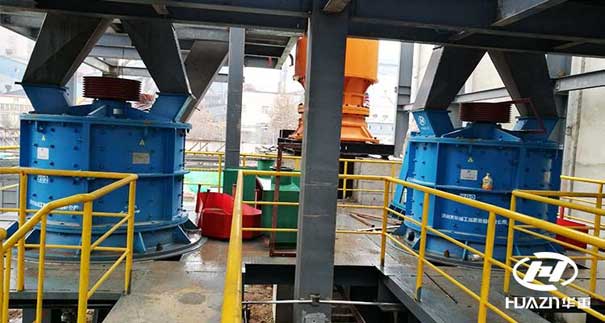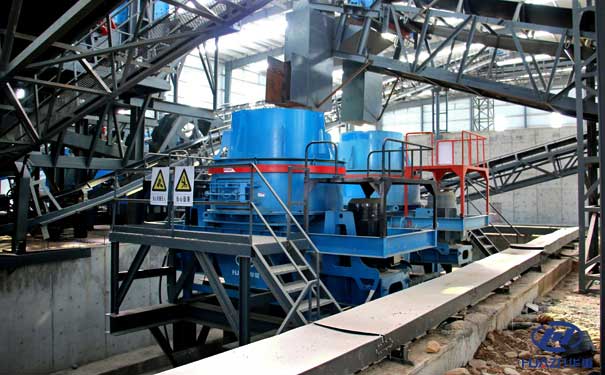Complex crushers and impact sand making machines are both models with a wide market share of machine-made sand equipment.
The working principle of the complex crusher is that the motor is driven by a V-belt to drive the rotor to rotate at high speed counterclockwise. The material enters the crusher cavity from the inlet, and is hit by the high-speed rotating plate hammer, and impacts on the teeth on the first counterattack plate on the top of the crushing cavity. The shaped counter-attack plate rebounds, and after continuously impacting and crushing with subsequent upward impact materials, it enters the second crushing chamber. Huge pressure, bending force and friction force are generated under the action of the wear-resistant tooth plate and the plate hammer. The materials are fully crushed and ground in the crushing cavity, the particle shape is fully reshaped, almost no needle-like materials exist, and finally discharged from the machine body.

The vertical impact crusher can also be used for rough grinding operations. It can crush the feed material smaller than 60mm, and the feed material of 2-8mm can be crushed to 18-100 mesh. Its working principle is: the material enters the crusher from the feed hopper, and the material is divided into two parts by the distributor. Part of it enters the high-speed rotating impeller from the middle of the distributor, and is rapidly accelerated in the impeller. Its acceleration can reach hundreds of times the gravitational acceleration, and then it is ejected from the three evenly distributed flow passages of the impeller at a speed of 60-75 m/s. When it comes out, it first impacts and crushes a part of the material that is freely falling around the distributor, and then impacts on the material lining in the vortex chamber together. It is rebounded by the material lining and impacts diagonally upwards to the top of the vortex chamber, and then changes it. The direction of movement is deflected to move downwards. The material emitted from the impeller flow channel forms a continuous material curtain. In this way, the material is subjected to two or more impacts, frictions and grinding and crushing effects in the vortex crusher. The crushed materials are discharged from the lower discharge port. A closed circuit is formed by the circulating screening system.

Generally, the material can be crushed to below 20 meshes after three cycles. In the whole crushing process, the materials will impact and crush by themselves, instead of directly contacting the metal elements, they will impact and rub against the material lining and crush. This reduces iron pollution. The ingenious air circulation inside the vortex cavity eliminates dust pollution. The working principles of these two devices are very different, and the advantages and disadvantages are also very different.
The compound crusher has a two-stage impact crushing cavity, all of which can be adjusted. The body is divided into upper and lower parts, which is convenient for installation and transportation. The rotor is connected with a taper sleeve and a key. Both the high-efficiency wear-resistant hammer and the impact plate can be plug-in installation. Both sides of the frame are equipped with unique symmetrical large opening doors. The hammer and impact plate can be opened and replaced. It has the characteristics of convenient operation and maintenance, high efficiency and energy saving, and the shape of the product is cubic. Used for sand making, the rate of sand formation at one time is above 30%, and the discharge granularity is adjustable and can be selected. Especially when crushing materials with high hardness such as river pebbles, granite, quartz stone, etc., the cost of producing machine-made sand per ton is as high as 5 yuan. However, the compound crusher has the advantages of low investment and high yield, which makes it accepted by users in the newly invested machine-made sand industry.

